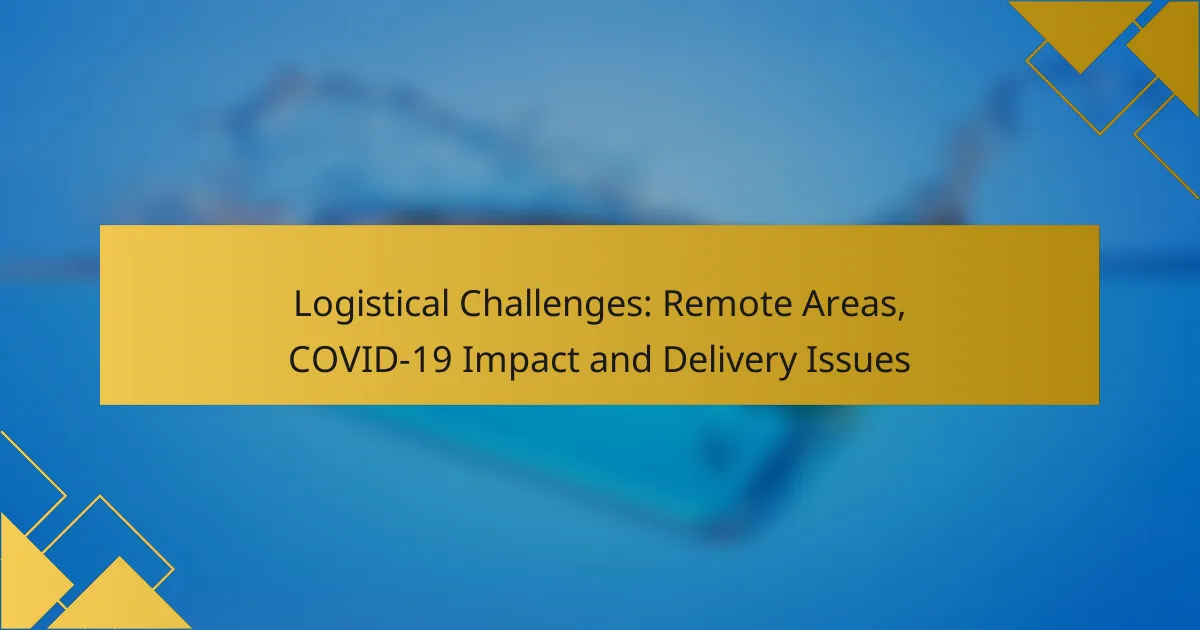Logistical challenges in remote areas have intensified due to the COVID-19 pandemic, which has disrupted supply chains and increased delivery times. Innovative solutions are essential to navigate geographical barriers and ensure efficient service, especially as restrictions and labor shortages complicate the delivery process. Addressing these issues requires leveraging technology and local resources to enhance accessibility and overcome infrastructure limitations.

What logistical solutions address delivery issues in remote areas?
Logistical solutions for delivery issues in remote areas focus on innovative methods to ensure timely and efficient service. These solutions often leverage technology and local resources to overcome geographical barriers and enhance accessibility.
Drone delivery services
Drone delivery services offer a fast and efficient way to transport goods to remote locations. By bypassing traditional road networks, drones can deliver packages directly to consumers, reducing delivery times significantly. Companies like Amazon and Zipline are already testing and implementing drone technology for medical supplies and everyday goods.
However, regulatory hurdles and airspace restrictions can limit the deployment of drones in certain regions. It’s crucial to stay informed about local regulations and ensure compliance to avoid operational setbacks.
Mobile delivery hubs
Mobile delivery hubs are vehicles equipped to serve as temporary distribution centers in remote areas. These hubs can store inventory and facilitate last-mile delivery, making it easier to reach customers without building permanent infrastructure. They are particularly useful in regions with limited access to traditional warehouses.
When implementing mobile hubs, consider the logistics of vehicle routing and scheduling to maximize efficiency. Proper planning can help minimize delays and reduce operational costs.
Partnerships with local carriers
Forming partnerships with local carriers can enhance delivery capabilities in remote areas. Local carriers often have established routes and knowledge of the terrain, which can lead to more reliable service. Collaborating with these carriers can also help reduce costs associated with last-mile delivery.
It’s important to evaluate potential partners based on their reliability, coverage, and customer service. Building strong relationships with local carriers can lead to improved logistics and customer satisfaction.
Use of GPS tracking technology
GPS tracking technology is essential for managing logistics in remote areas. It allows businesses to monitor the location of deliveries in real-time, providing transparency and improving customer communication. Customers can receive updates on their shipment status, enhancing their overall experience.
Implementing GPS tracking requires investment in software and devices, but the benefits in efficiency and customer satisfaction often outweigh the costs. Ensure that your tracking system integrates seamlessly with existing logistics operations.
Community-based delivery networks
Community-based delivery networks leverage local resources and volunteers to facilitate deliveries in hard-to-reach areas. These networks can be particularly effective in rural communities where traditional delivery services may be lacking. By engaging local residents, businesses can create a more sustainable and responsive delivery system.
To establish a community-based network, consider recruiting volunteers and providing them with training and resources. Clear communication and coordination are key to ensuring that deliveries are made efficiently and reliably.

How has COVID-19 impacted logistics in remote regions?
The COVID-19 pandemic has significantly disrupted logistics in remote areas, leading to increased delivery times and challenges in maintaining supply chains. Restrictions on movement, labor shortages, and heightened health protocols have all contributed to these logistical hurdles.
Increased delivery delays
Delivery delays have become more common in remote regions due to various factors, including transportation restrictions and limited access to delivery services. Many logistics companies have reported delays ranging from several days to weeks, depending on the location and the severity of local restrictions.
For instance, areas that rely on air freight may experience longer wait times as flights are reduced or canceled. Customers in these regions should anticipate potential delays and plan accordingly when ordering goods.
Supply chain disruptions
Supply chain disruptions have been widespread, affecting the availability of essential goods in remote areas. Factors such as factory shutdowns, border closures, and transportation limitations have led to shortages of products, from food to medical supplies.
Businesses operating in these regions must adapt by diversifying suppliers and exploring alternative sourcing options to mitigate the impact of these disruptions. Establishing strong relationships with local suppliers can also help ensure a more reliable supply chain.
Changes in consumer demand
The pandemic has altered consumer demand patterns, with some products seeing a surge while others decline. For example, there has been an increased demand for health-related items and home delivery services, while non-essential goods may see a drop in interest.
Logistics providers should monitor these changing trends closely and adjust their inventory and delivery strategies accordingly. Understanding local consumer behavior can help businesses better meet the needs of their customers during these uncertain times.
Health and safety regulations
Health and safety regulations have become a priority in logistics, especially in remote areas where healthcare resources may be limited. Companies must comply with guidelines from health authorities, which may include sanitization protocols and contactless delivery options.
To navigate these regulations effectively, logistics providers should stay informed about local health guidelines and implement necessary changes to their operations. This not only ensures compliance but also builds trust with customers who are increasingly concerned about safety during the delivery process.

What are the key challenges of delivering goods to remote areas?
Delivering goods to remote areas presents several significant challenges, including limited infrastructure, high transportation costs, weather-related disruptions, and restricted access to technology. These factors can complicate logistics and increase delivery times and expenses.
Infrastructure limitations
Infrastructure limitations in remote areas often include poorly maintained roads, lack of reliable transportation networks, and insufficient storage facilities. These issues can lead to delays and increased costs, as delivery vehicles may struggle to navigate rough terrain or may not have access to necessary loading and unloading points.
For instance, in rural regions, roads may be unpaved or prone to flooding, making them impassable during certain seasons. Companies must assess the infrastructure before planning deliveries to avoid unexpected challenges.
High transportation costs
High transportation costs are a major concern when delivering goods to remote locations. The expenses associated with fuel, vehicle maintenance, and driver wages can significantly increase overall delivery costs, often making it less economically viable to serve these areas.
For example, transporting goods over long distances may require specialized vehicles or additional logistics support, which can further inflate costs. Businesses should evaluate whether the potential market in remote areas justifies these expenses.
Weather-related disruptions
Weather-related disruptions can severely impact delivery schedules in remote areas. Harsh conditions such as heavy snowfall, rain, or storms can hinder transportation and lead to delays or cancellations of shipments.
Companies should monitor weather forecasts and plan accordingly, possibly scheduling deliveries during more favorable conditions or using alternative routes to mitigate risks associated with inclement weather.
Limited access to technology
Limited access to technology in remote areas can complicate logistics and hinder effective communication. Many remote regions may lack reliable internet or mobile connectivity, making it difficult to track shipments or coordinate with delivery personnel.
To address this, businesses can invest in offline tracking solutions or establish local partnerships to enhance communication and ensure smooth operations despite technological limitations.

What criteria should businesses consider for logistics in remote areas?
Businesses must evaluate cost-effectiveness, delivery speed, and reliability of service providers when planning logistics in remote areas. These criteria help ensure that operations remain efficient and meet customer expectations despite geographical challenges.
Cost-effectiveness
Cost-effectiveness in logistics for remote areas involves balancing transportation expenses with service quality. Businesses should analyze shipping rates, fuel costs, and potential tariffs to find the most economical options. Utilizing local suppliers can often reduce costs significantly.
Consider implementing a tiered pricing model based on delivery distance. For instance, deliveries within 50 kilometers may have lower rates compared to those exceeding 200 kilometers. This approach helps manage expenses while maintaining service levels.
Delivery speed
Delivery speed is crucial for customer satisfaction, especially in remote regions where delays can be common. Businesses should assess the average transit times of various carriers and choose those that can meet their delivery deadlines. Fast delivery options may come at a premium, so it’s essential to weigh speed against costs.
Utilizing regional distribution centers can enhance delivery speed. For example, a business might establish a hub in a central location to serve multiple remote areas, reducing overall transit times and improving service efficiency.
Reliability of service providers
Reliability of service providers is vital for maintaining consistent logistics operations in remote areas. Businesses should research potential carriers, looking for those with a proven track record of on-time deliveries and minimal service disruptions. Customer reviews and industry ratings can provide valuable insights.
Establishing partnerships with multiple logistics providers can mitigate risks associated with reliability. If one carrier experiences delays, having alternatives ensures that deliveries continue without significant interruptions, ultimately preserving customer trust and satisfaction.










